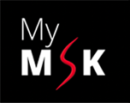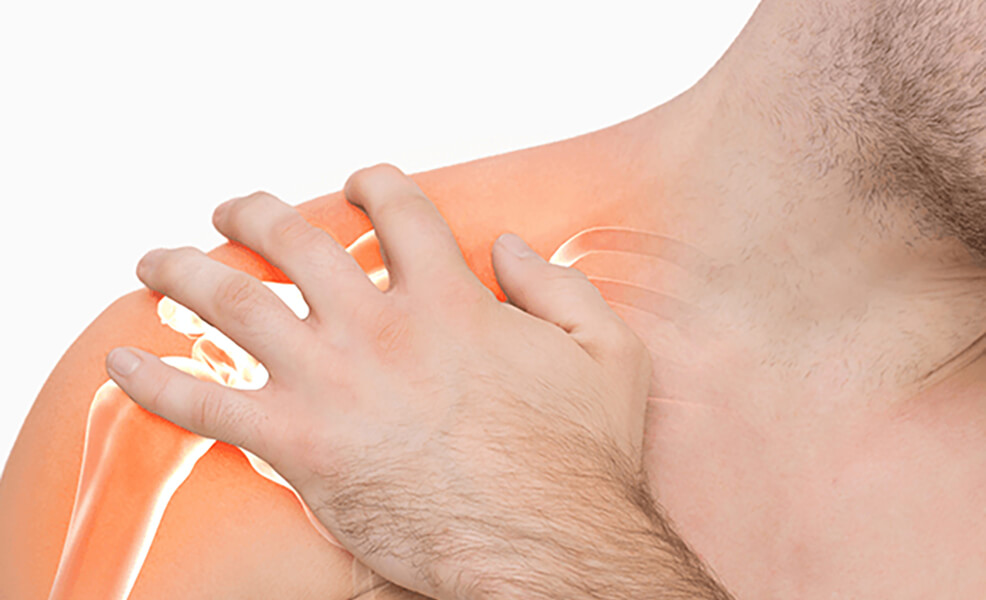
AC joint pain is a very common cause of shoulder pain and can affect people of all genders and ages. When severe, it can interfere with daily activities. In addition, it can also prevent people from participating in exercises such bench pressing and overhead sports like tennis.
What is the AC joint?
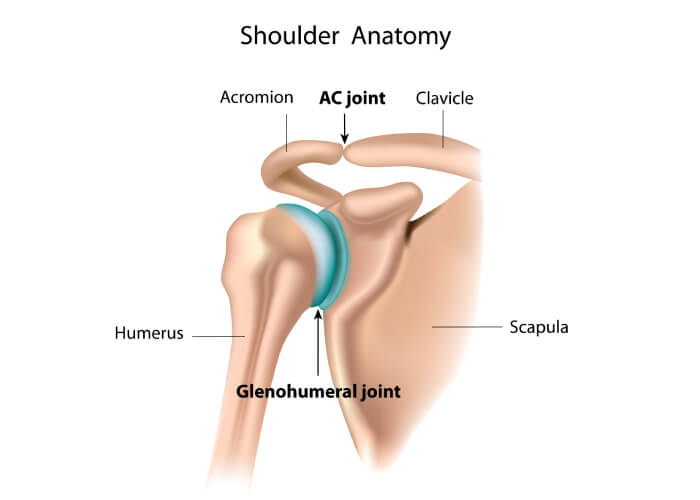
The AC Joint or the Acromioclavicular Joint is present in the shoulder where two bones, namely the clavicle (collarbone) and the acromion meet each other. The acromion is a part of the scapula (shoulder blade) which can be felt at the top edge of the shoulder
Like all joints, the AC joint also has cartilage between the two bones. It is this cartilage that allows both bones (Acromion and Clavicle) to move without friction.
When this joint is inflamed or has degeneration, pain is often the result.
The pain in the acromioclavicular joint is often referred to as ACJ pain or AC Joint Pain.
Symptoms of AC Joint Pain
The primary symptom of AC joint pain is pain at the top of the shoulder, at the juncture where the clavicle meets the acromion. The pain slowly radiates to the side of the neck and ear. The inflammation and pain are made worse by certain activities such as
- Performing overhead activities
- Sleeping on the affected shoulder
- Moving the affected arm over the opposite shoulder
Gradually, ACJ osteoarthritis develops, and the symptoms get progressively worse and more painful. As a result, you may be in constant pain as you perform your daily activities and may even wake up at night.
The symptoms of AC joint pain can also start when there’s a joint dislocation at the AC joint. AC joint separation or sprain is also the most common reason for AC joint pain. It can happen when the ligaments that connect the shoulder blade and the collar bone become inflamed and separated. The severity of the pain varies from mild (stretched ligaments) to severe (torn ligaments).
If the ligaments are torn, this can be felt on top of the shoulder as a bump or a ‘step’.
People with an AC joint dislocation find it challenging to move their hands above shoulder level. Likewise, stretching their arms across the midline of the body, above the shoulder level, is also quite painful.
Causes of AC Joint Pain
General wear and tear in the AC joint is the most common cause of AC joint pain. The fibrocartilage deep within the joint wears away after the age of 40 so pain is common over the age of 40.
In addition, there are also a significant number of people who experience AC joint pain due to trauma caused by falling onto the side of the shoulder. The injury can damage the joint capsule and ligamentous structure of the AC joint resulting in joint instability.
Briefly listed here are causes of AC joint pain.
- Trauma – Shoulder injuries such as ligament ruptures, dislocations and fractures
- ACJ osteoarthritis – The risk increases with age, mostly from 40 years onwards. However, shoulder injuries can cause an early onset of ACJ osteoarthritis
- Occupation – Jobs involving heavy machinery and repetitive shoulder movements can increase strain on the shoulder joint. This includes keyboard work
- Sports – Sports that involve overhead activities such as tennis and weightlifting also cause an early onset of ACJ osteoarthritis. In the bodybuilding AC joint pain is known as benchers shoulder
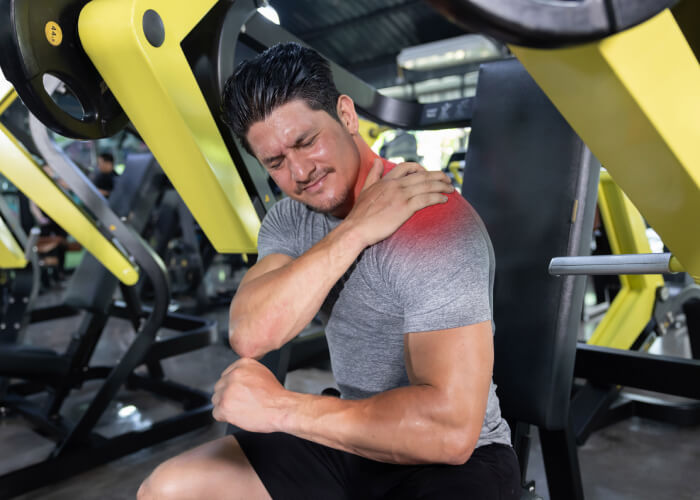
- Rheumatoid arthritis and other inflammatory conditions can also cause AC joint pain.
AC joint pain is common among weightlifters due to the frequent bench pressing and other over the shoulder activities, so much so that it is also called Bencher’s Shoulder. The lifting activities can cause inflammation and Arthritis of the distal clavicle (the end of the collar bone), where it meets the acromion within the AC joint.
Diagnosis of AC Joint Pain
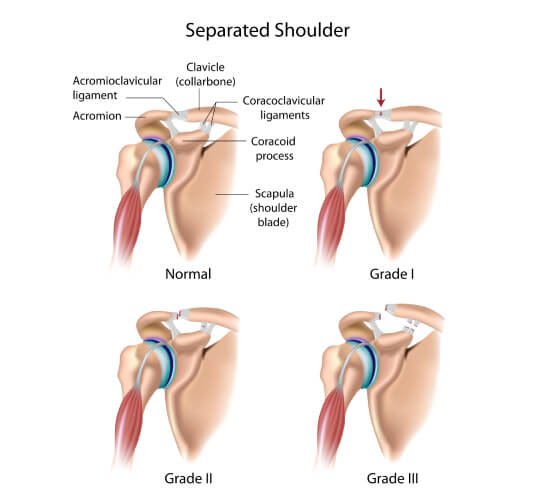
The diagnosis of AC joint pain starts with a series of questions specific to your condition along the likes of:
- Where does it hurt?
- How did the injury occur?
- What are your symptoms?
- Are you in pain? If so, how painful is it?
The questionnaire is followed by a physical exam where the doctor will assess the mobility and strength of the shoulder.
The Shoulder ‘Scarf’ test is often positive. This involves moving the outstretched arm across the body. Shoulder Abduction beyond 90 degrees may also cause pain
The clinician may also feel around the bones and the tissue connecting the clavicle and acromion. They may also suggest additional tests such as X-rays or an ultrasound scan
If an AC joint dislocation has been diagnosed, you will undergo further X ray to assess the severity of the injury.
Grade 1: Mild separation involving a sprain of the AC ligament.
Grade 2: Torn AC ligament, with the CC ligament, sprained or slightly torn. The clavicle may fall out of alignment.
Grade 3: The AC and CC ligaments are torn, and the shoulder is visibly out of position.
Treatment of AC Joint Pain
The treatment of AC joint pain varies depending on the severity of the dislocation. In mild cases, you can manage it with rest, analgesia, and physical therapy.
- Rest from aggravating movements and workouts which involve overhead activity or stress on the AC joint
- Topical anti-inflammatory creams can be applied to the injured area.
- Physiotherapy to restore regular joint movements and reduce pain. In addition, sports taping can help relieve pressure on the joint.
- Postural corrections and manual therapy can help strengthen the shoulder.
- Cortisone injection to the AC joint can help with the pain by reducing inflammation and swelling.
- Rhomboid exercises such as shoulder blade squeeze, seated back rows and resistance band pullbacks help increase mobility and muscle strength.
- Prolotherapy – Prolotherapy to the AC joint can help stabilise ligaments around the joint
In cases where conservative pain management doesn’t work, the following treatment plans may work for you.
- Steroid based injections can help reduce pain, swelling and inflammation.
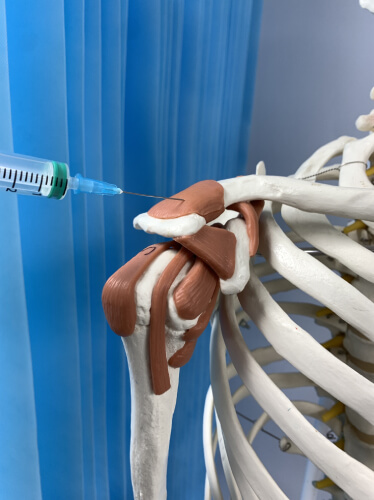
- Ostenil injections are a relatively new treatment that helps with osteoarthritis and joint inflammation symptoms.
- Severe cases will require surgery. Doctors will perform keyhole surgery to remove the end of the clavicle and open up the joint. This is called Joint excision and helps where all other measures have failed
Final Word
While it can be challenging to treat AC joint pain, you can avoid the damage due to overuse of the AC joint via postural correction and rehab.
Over time you may develop ACJ osteoarthritis despite these measures and this is where Ostenil Injections or Prolotherapy may really help strengthen the joint or slow down degeneration.
In addition, participating in fitness programs that increase strength, flexibility and balance can help with preventing AC joint Pain.
Finally, if you have a previously injured AC joint, ensure that you wear protective equipment during contact sports like rugby and football.
Frequently Asked Questions
1. Will AC joint pain heal on its own?
In most cases, the AC joint pain will heal in 2-3 weeks but require pain medication and physiotherapy. More severe cases will require Cortisone or Ostenil Injections and surgery.
2. Where do you feel AC joint Pain?
You can feel the AC joint pain at the top of the shoulder, where the clavicle meets the acromion, the highest point of the shoulder blade. This is often felt as a palpable lump at the top of the shoulder.
3. Can I work out with AC joint injury?
A varied range of motion exercise program is recommended in the recovery period. It is important that you keep the shoulder moving as much as you can tolerate the pain.
